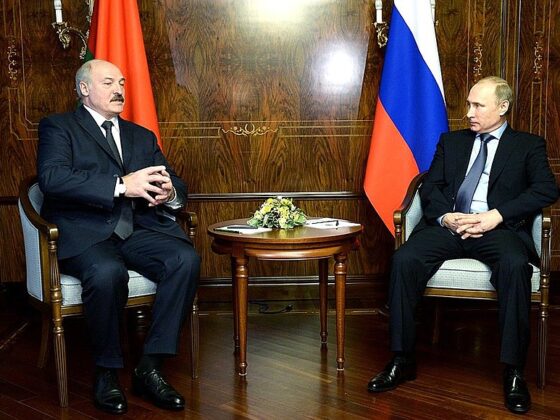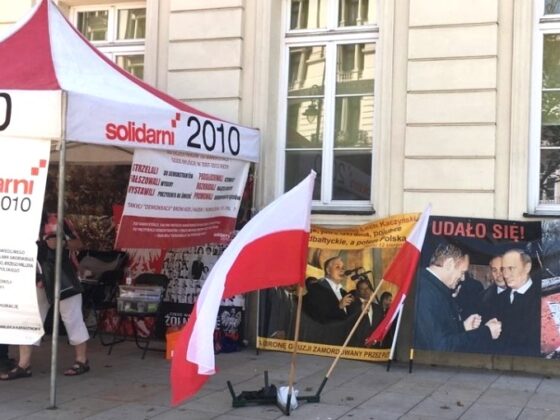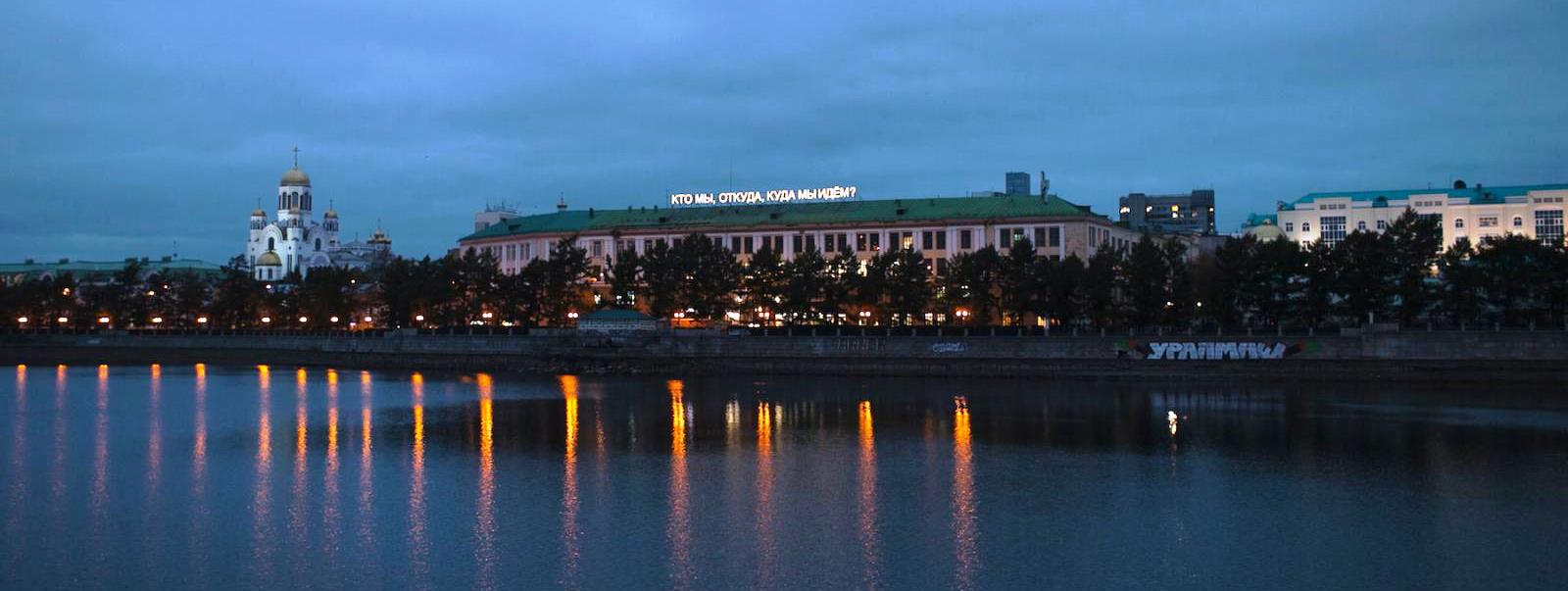
An artist’s rooftop inscription in Yekaterinburg asks: “Who are we? Where are we from? Where are we going?” (credit)
In the summer of 1996, President Boris Yeltsin, who had just been reelected for a second term, commissioned a group of Russian intellectuals to design a new national idea for the country. It was a virtually impossible task: putting together a set of ideals and values and conceptions of a common past and future that can bring a society together and help set national goals. However, this can only take shape over the course of long-lasting historical developments rather than be produced by a specially designed brainstorming team on a fixed deadline.
And yet, Yeltsin’s line of thinking was clear: the collapse of Soviet ideology left behind a values vacuum. A return to the family of “normal civilized countries”, the consumption values that in the Soviet Union had been condemned as bourgeois, the new opportunities provided by the free economy and private property – in the 1990s all those values and reference points of the new Russia more often than not divided the society. A large part of Russians had suddenly found themselves in unfamiliar socio-economic situation. They were unprepared for the new opportunities, did not know how to take advantage of them, and would not see them as beneficial.
Russia appeared to be in need of a grand idea that would be able to compete with the Soviet project, an idea that would bring the nation together and explain to its members what constituted their shared identity.
|
“The vacuum left after the rejection of Soviet values was filled with similar ones, yet in a symbolic, decorative representation.” |
Such an idea was found not in the ideological realm, however, but in the aesthetic one. The vacuum left after the rejection of Soviet values was filled with similar ones, yet in a symbolic, decorative representation. Two extremely successful television series produced by the main state-run television channel, “The Russian Project,” a series of short video clips dealing with social issues, and the even more successful, “Old Songs About Important Things,” did not emphasize the rift with the Soviet period but instead stressed a continuity with it.
Popular Soviet actors, songs from Soviet movies, the “warm” and “soulful” tones of Soviet television, all conveyed an unambiguous message: unlike in the 1990s, we are no longer talking about a rift from the Soviet past or building a new Russia from scratch. Life goes on, and we will borrow from the Soviet past everything that had been dear to us: songs, movie quotes, warm relations among people, and a strong state that takes care of its citizens.
The phenomenal success of those television projects and the nostalgia for the late Soviet period that they aroused laid bare a new national idea that Russian society was willing to accept, an idea that came down to new consumption values in the old Soviet setting. That was also the essence of the ideology of Putin’s Russia that was taking shape gradually and haphazardly.
Everyday life may have been about shopping malls, consumer credits, and new gastronomical or tourist experiences. But at the symbolic level, Russian life included a return of the Soviet anthem, Soviet films, and nostalgic TV shows, as well as a return of Cold-war-styled foreign policy rhetoric and glorification of the Great Victory. A Russian citizen taking a bank loan in order to buy a German-made car could at the same time easily find himself in a symbolic trench ready to repel a foreign invasion.
| “At the symbolic level, Russian life included a return of the Soviet anthem, Soviet films, and nostalgic TV shows, as well as a return of Cold-war-styled foreign policy rhetoric and glorification of the Great Victory.” |
This ideology reached its prime and took its final shape following the 2014 incorporation of Crimea into the Russian Federation and escalated conflict with the West. For the first time in post-Soviet Russia, the government pursued a consistent cultural policy that included sponsoring films about WWII heroes, erecting across the country monuments to military commanders and Russian Orthodox saints, and introducing patriotic education and classes of Orthodox culture in public schools.
In the most general terms, this set of ideas comes down to the following: Russia is, first and foremost, a strong state. All the state and spiritual leaders of the nation who had contributed to building this strong state are the current leader’s associates, allies and predecessors. The state must be strong because Russia is always encircled by enemies who dream of seizing its natural wealth and destroy its spiritual integrity. Russia has preserved the faith, purity, and truth that the West has lost—this is why the West harbors envy and spite toward Russia. It is thanks to the strong state and the natural faith and purity that Russia has been able to fulfill its universal historical mission: to defeat fascism and save the planet from the most powerful evil in human history. If needed, we can do this again.
The new state patriotism embodied primarily by the current minister of culture, Vladimir Medinsky, draws on a range of ideas deeply rooted in Russian culture: faith in a good Tsar, suspicion of foreigners and those professing different faiths, and nostalgia for various versions of “Russia that we have lost.”
The glorification of Victory Day and the new rituals associated with it, first and foremost the annual nationwide procession called the Immortal Regiment, are rooted in the deeply emotional experience of WWII—a sense of the losses in that war and the Soviet victory as matters of personal pain and personal pride.
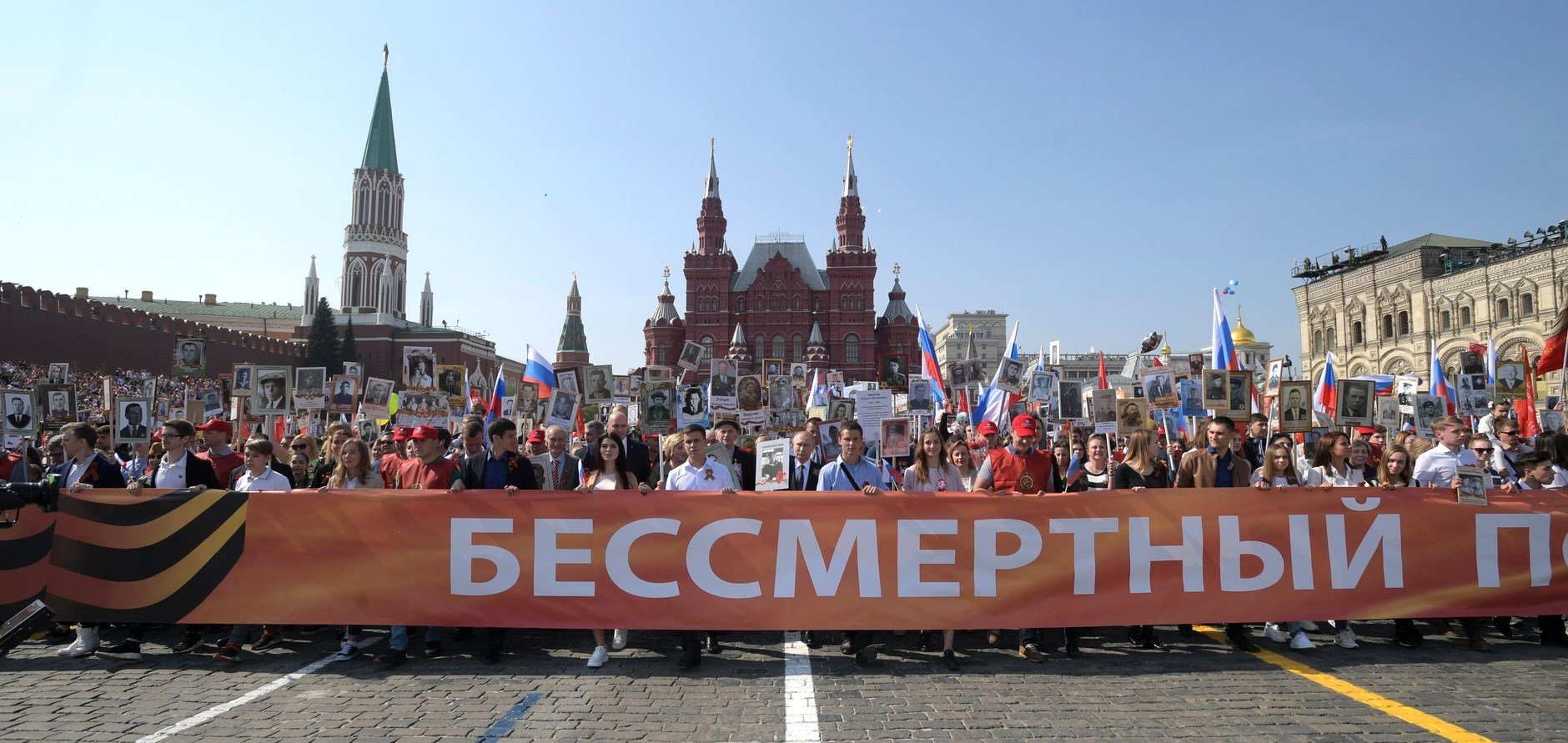
An Immortal Regiment march on Victory Day, May 9, 2019 (credit).
Yet, the concept of national identity offered by today’s government remains, in part, a mere decoration, an exercise in propaganda. The everyday experience of a contemporary Russian who is largely incorporated into the global world—as a tourist, or a consumer, or a link in the international division of labor—is barely compatible with the ideology of a “besieged fortress” rooted in the past.
The image of Russia as a nation with a great past, and of its national leader as a successor of the earlier rulers, focuses on him as the mastermind of all the accomplishments of today. This precludes any discussion of the future and, in its turn, creates a new values vacuum, and a new identity crisis.
|
“The everyday experience of a contemporary Russian who is largely incorporated into the global world is barely compatible with the ideology of a ‘besieged fortress’ rooted in the past.” |
As a result, as it has often happened in history, in response to a “Russian idea” channeled from above, another version of patriotism and national identity is gradually emerging from below.
This grassroots “ideology” does not have an organizing or brainstorming center. It can be referred to as an ideology only with reservations. We can observe only its individual manifestations – in the works of street artists and at modern art exhibitions, in the characters of Russian YouTube videos, in the tracks of Russian hip-hop stars, and in daily habits and practices that organize people’s lives in a new way and shape their mindset.
The sense of togetherness and national belonging is built not just by the rituals of commemoration of great feats of the past, but also by numerous practices by grassroots organizations. When members of the same profession sign various collective letters in defense of the victims of arbitrary court decisions, or when residents of cities or neighborhoods come together in social networks or join campaigns against development projects or landfills, or when children’s’ parents join WhatsApp chats—these types of activities contribute to a sense of community with one’s neighbors or fellow professionals, not just as citizens of a great nation. This sense of community raises the awareness of one’s interests as a member of a social group and enables one to stand up for those interests.
Solidarity skills are formed in joint charitable activities, such as environmental protection or historical landmark preservation that are seen by all members of the community as good and socially approved. New grassroots communities are being built around good deeds, and this joint ethical involvement creates social bonds that are at least as strong and close as the connection with a great national history or the legacy of forbearers.
These social bonds are frequently formed “on the ground” over the course of protecting or collectively beautifying an apartment building or neighborhood. Russian people, whose concept of “my territory” was traditionally confined to one’s apartment, have started to encompass one’s courtyard, neighborhood, or city.
| “This process of joint “interiorization of spaces” generates a new, local-level patriotism and a sense of belonging to a concrete place that should be treated with care and love.” |
This process of joint “interiorization of spaces” generates a new, local-level patriotism and a sense of belonging to a concrete place that should be treated with care and love. Patriotism of this kind calls for a reinterpretation of local identity: the realm of ideas and developments that are recognized as cultural values and important local heritage is continuously drifting away from the normative official version.
One of the major Russian news items this year was the protest rallies of unprecedented scale in Yekaterinburg whose city residents protested against the construction of a church in one of the centrally located parks. This episode is noteworthy not just because of the residents’ perception of the park as a valuable public property (the official line treated the church as a crucial element of national cultural identity, but the residents refused to regard the church as having undisputed value). The protest against the church should be seen in the context of the rise of cultural initiatives in Yekaterinburg. One of them has been launched by a group of young architects who came together for the restoration and preservation of an abandoned landmark of constructivism, the so-called White Tower, which is located in the Yekaterinburg outskirts. They raised funds for its restoration and maintenance, organized exhibitions and tours of it, and turned the abandoned building into a de-facto symbol of Yekaterinburg. In 2018, they organized next to the White Tower the first national Forum of Preservers of Towers and Caves.
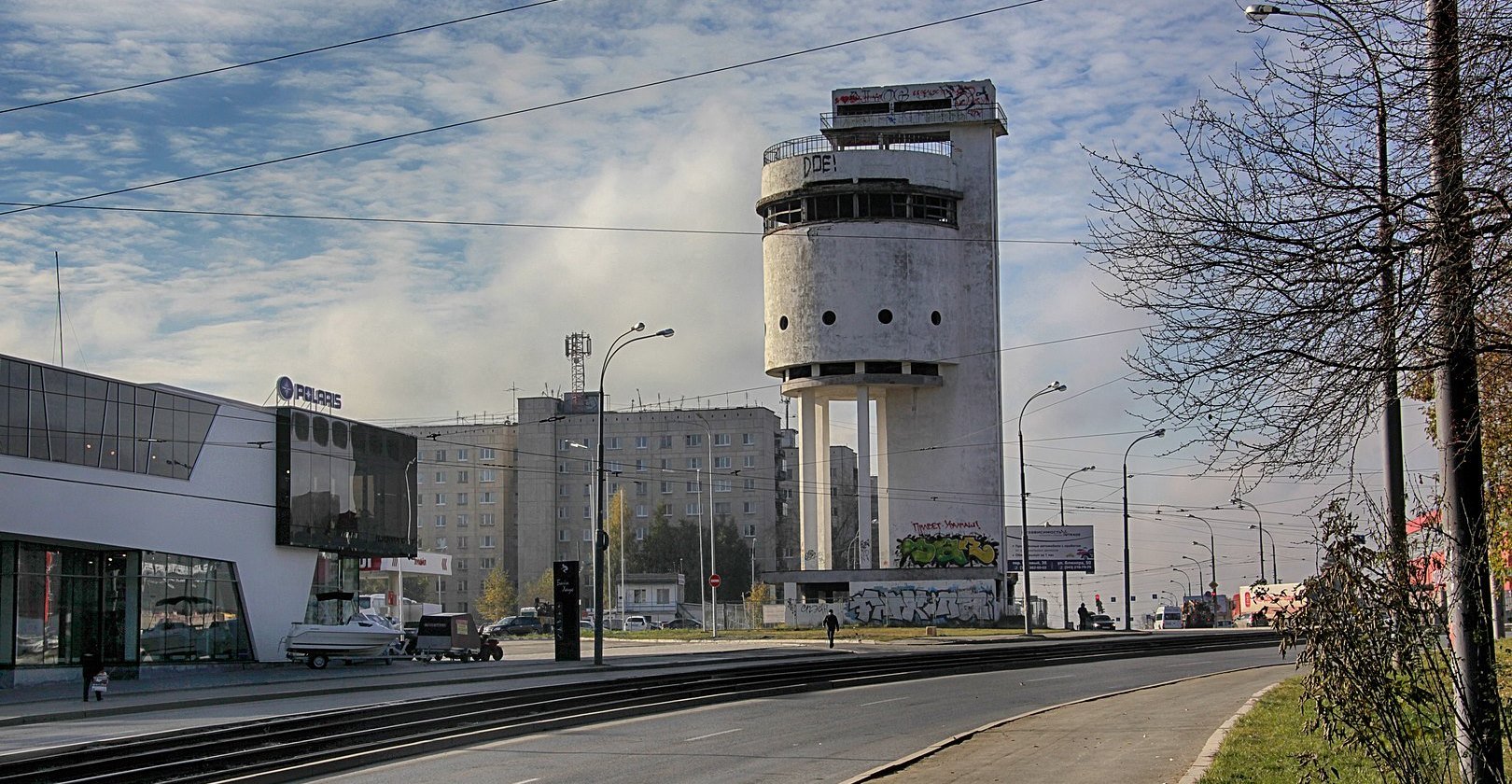
The “White Tower” in the Uralmarsh district of Yekaterinburg (credit).
Further, young historians have conducted guided tours of Yekaterinburg’s constructivist architectural heritage, and a local university has organized exhibitions and published albums of B. U. Kashkin, a street musician and artist who sang “naïve” songs and drew “naïve” pictures in one of the centrally located pedestrian streets. Young musicians have united around charismatic managers of the local opera and ballet theater that, in a matter of just a few years, has evolved as one of the most progressive musical theaters in Russia. Finally, one of the downtown buildings is now adorned with a mysterious work by street artist Timofey Radya with gigantic neon letters saying: “Who are we? Where are we from? Where are we going?”
All of these contribute to Yekaterinburg’s new image and are regarded as important elements of local cultural heritage. As a result, those who took to the street to protest against the church project that was imposed from above were no longer mere “oppositionist activists” but people who share a sense of being masters of their own city, ready to stand up for their own view of its values.
Yekaterinburg is not an exception. Similar developments nurtured by local patriotism, an interest in local history, and a rethinking of local identity have unfolded with varying intensity in many large urban centers. The rethinking of local identity goes side-by-side with an aesthetization of the daily lives of rank and file urban dwellers.
We see “bedroom suburbs” that have been traditionally regarded as barely livable and certainly deserving no admiration being suddenly picked up as expressive settings for music videos or fashion shoots or as material for modern artists and filmmakers.
The pre-fab concrete block fad has partially returned to Russia from the West. Over the past several years, European photographers and curators searching for new brutalist styles have cultivated the aesthetic of “tough guys in sweat pants in prefab neighborhoods.” And now this aesthetic is returning home and, in a sense, reshaping the very image of the motherland. Video clips of musicians Max Korzh and Husky, the fashion collections and photography of Gosha Rubchinsky, and works by artist Pavel Otdelnov and photographer Aleksandr Gronsky, all work one way or another with the aesthetic of multi-storied “bedroom suburbs” reinterpreting it as a value.
|
“Unlike the 2000s generation that often regarded post-Soviet imagery as something shameful that needs to be overcome or resconstructed, to the 2010s generation it is an element of their collective memory.” |
This “new landscape” (the title of last year’s large photography exhibition devoted to post-Soviet daily life) is displayed without irony or exoticization, as a natural, almost untouched, and therefore, valued environment, inspiring warm feelings.
Unlike the 2000s generation that often regarded post-Soviet imagery as something shameful that needs to be overcome, transfigured, or reconstructed, to the 2010s generation it is an element of their collective memory. Yes, these are shabby-looking high-rises, but this is where we grew up. These buildings have a lot of life and strength in them, there are no buildings like these anywhere in the world. This is our true motherland calling for sympathy, care, and love.
A new perception of urban space is related to the new perception of historical time. Official “ideology” demands that the Soviet period be seen as a time of pride and glory (or, at least, as a cause for nostalgic recollections), while the 1990s should be regarded as a time of criminal lawlessness, so any return to these days be deemed as the most horrible thing possible. But this cultural policy finds little response among young Russians who, in the words of political scientist Ekaterina Schulmann, lack “Soviet focal points” in their brains. Their nostalgia is centered on the “wild 1990s” as the time of their childhood.
The 1990s have become a virtual home, an inexhaustible source of images and topics for young Russian film-makers. All of the recent high-profile debuts, such as Kantemir Balagov’s “Closeness,” Aleksandr Khant’s “The story of Vit’ka Chesnok taking Lyokha Shtyr’ to a Nursing Home,” Darya Zhuk’s “Chrystal Swan,” Boris Akopov’s “The Bull,” work with a rethinking of the 1990s and treat it as a time of hardship, but also a thrilling and heroic time of strong people and strong emotions.
For Russian cinema, the 1990s have become what the Prohibition was for late 20th-century Hollywood: a time where one does not want to return, but that is extremely interesting to film. The 1990s is the timeframe for an unannounced series produced by Yuri Dud’, Russia’s most popular YouTube journalist who made several documentaries about that decade’s heroes and its most momentous developments, from the Chechen war to the dawn of Russian MTV.
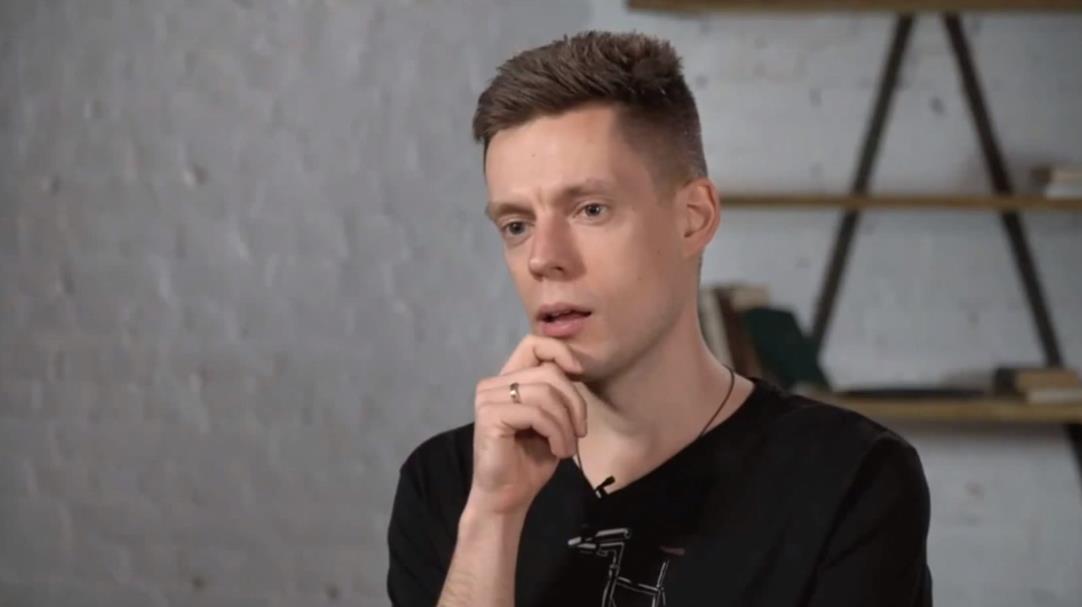
Popular YouTube journalist Yuri Dud’ (credit).
For the generation of today’s 20-year-olds, the 1990s is not a decade that should be erased from history or overcome at any cost. Rather, it is a time when their motherland begins, one that should be accepted and remembered, its failures and horrors notwithstanding. This basic acceptance is the feeling that endows the conversation about Russia’s past with a new intonation, a conversation whose main subject is its unspoken traumas and unreflected tragedies.
In this conversation, too, Yuri Dud’ plays a key role. Dud’ quit working at state television, launched his own show on YouTube, gained popularity by his scandalous interviews with hip-hop stars, and then offered his gigantic audience several serious journalistic works, first and foremost, documentaries about Stalin’s camps in Kolyma and the 2004 terrorist attack in Beslan. These films tell the young generation about the tragic episodes of the past that today’s Russian government tries to play down. Dud’ tells these stories not from a government perspective, but from the standpoint of a citizen who asks hard-hitting questions about those tragedies that the government would rather not discuss.
The Beslan documentary provoked a wave of hatred among television propagandists who accused Dud’ of justifying the terrorists—because Dud’ made clear that the explosions and the fire in the Beslan school building that killed over 300 hostages, most of them children, had been probably caused by the operations of the special security forces. But having seized upon Dud’s version of the Beslan tragedy, which was inconvenient for the present Russian administration, the state television propagandist may have missed something in that documentary that is more important – and more dangerous for them.
Dud’s films are not reduced to a discussion of the tragedies and crimes committed by the government. They also show people who are living today in Beslan and Kolyma—people who have endured in a climate unfit for human existence or lived through a tragedy of such scale that no one can survive. Yet, here they stand poised, strong, responsible, and independent. They do not rely on the help of the state and are ready to build their lives independently of it.
These are people you want to emulate, in whom you can see an image of a Russian future in which you would like to find yourself, and one that looks entirely different from the image of Russia created by government propaganda that seeks to keep the country in an eternally frozen past.
Yury Saprykin is a cultural commentator and head of the Polka educational project.



